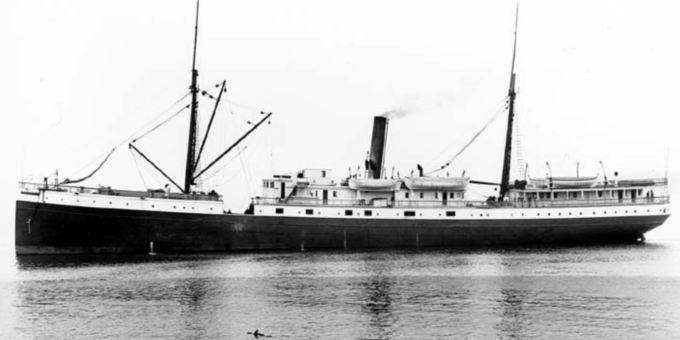
“All hope gone!
“Not a woman on board is saved!
“Such was the pitiless message that flashed over the wires last night to the Van Wyck household, killing at a blow the thin, small hope that Laura – the beautiful, well-beloved Laura Van Wyck – might have braved the battle with the strength of youth and been carried or tossed ashore, and was even then waiting in the black, bleak wilderness to send a message of cheer to the loved ones at home.
“But the hope died and its white ashes strewed the hearthstone, already wet with tears.
“The mother, until now brave in the face of the impending sorrow, heard the message that bared the truth, and with a cry sank into the arms of her sons.” [1]
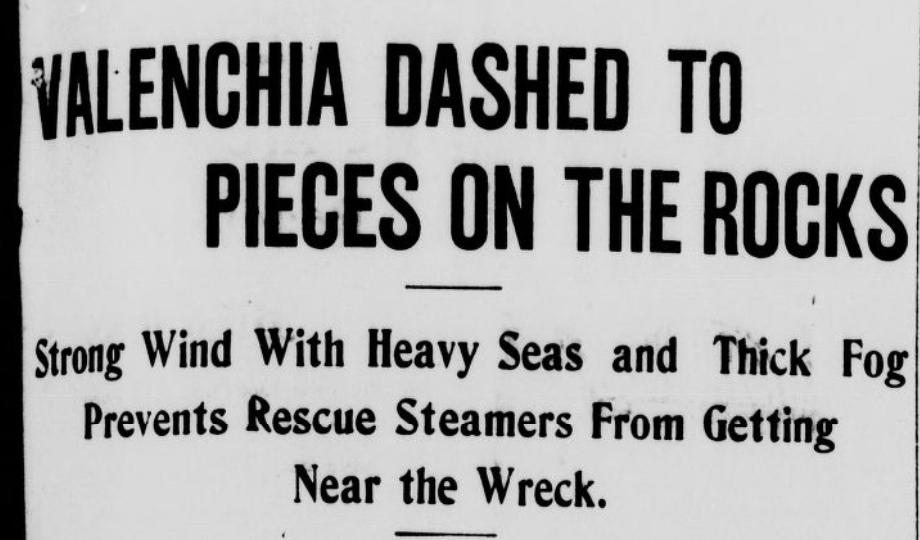
The Wreck of SS Valencia
On January 22, 1906, the Valencia hit a reef near Vancouver Island’s southwest coast. The stormy weather had dangerous heavy winds and high waves.
Roughly 136 people died, including all the women and children on board. Only 37 men survived the ordeal.
One of the survivors gave his version of what happened that fateful day. He said:
“”The ship struck… [and] In an instant all was excitement. The vessel reeled, slid over the reef, and struck again.
“The command to back it off was given and it went astern at full speed, but it was too late. The water was pouring in like a mill race, with a sound which drowned the cries and shrieks. The wind swung the vessel’s stern to the beach and its head to the waves. This saved many lives, as it was then swept back to the shore, and struck once again in such a position that it remained partially above the water and on an even keel.
“Every wave now washed clear over it, and many people who hastily rushed to the deck were swept into the sea.
“An order was given to get out the boats. Two of them on the weather side were launched, but were smashed as soon as they struck the water. Then came the attempt to get out the lee boats. Purser O’Farell took charge. Four women and a number of men went into the boat. I do not know how many, but it was practically full. Just as they were lowering the other the davits broke and the stern of the boat fell to the water, while the bow hung in the air.
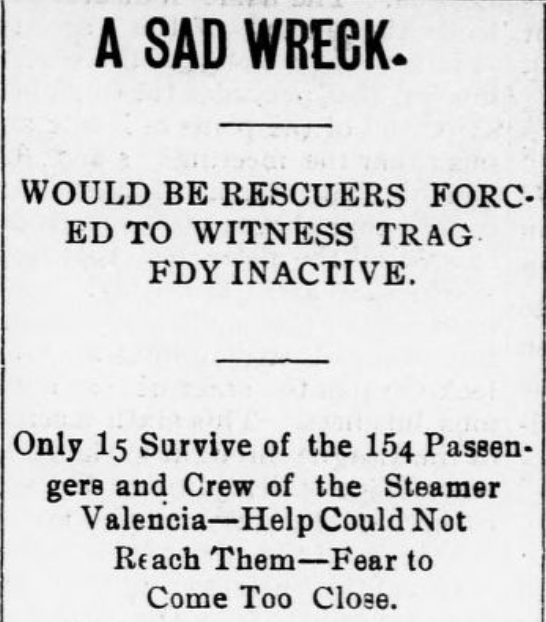
“Every one in it was thrown into the sea and swept away in an instant. For a second or two I caught a glimpse of an agonized face, then another, and yet another, as they were washing by me. It was awful. The waves dashing over the ship swept the deck loose and every swell lifted it. We clung to the rigging and the deckhouse. Then an attempt was made to get a line ashore. A fireman… agreed to swim ashore. He was in the water fully half an hour, but was unable to make the beach.
“One man was swept ashore and succeeded in landing on a small rock. We shot a line to him and then he tried to climb the cliff, but he fell and was killed before our eyes.
“One of the most pitiable incidents was that of a little boy about five years old. His father, mother, and two little sister put off in one of the boats. The boat was capsized and all were drowned. The little fellow waded about the deck, crying for his parents. The last I saw of him he was clinging to the rigging. There were many similar cases.
“By Wednesday morning the ship was rapidly going to pieces. Every swell carried away a portion of the vessel, and the decks rose and fell with every breaker. It was impossible to stay on deck without clinging to a support. The ship was sunk to about the level of the hurricane deck.
“In the morning, about fifteen or twenty persons, among them one or two women, were clinging to the rigging in the fore topmast. They appeared to be in the safest place, as it was removed from the wash of the waves, although the flying spray dashed over their heads. Suddenly, and without warning, their mast tottered, and there came a shriek from those on it, and, the next moment it fell with a crash. I do not think there was a single one saved.” [3]
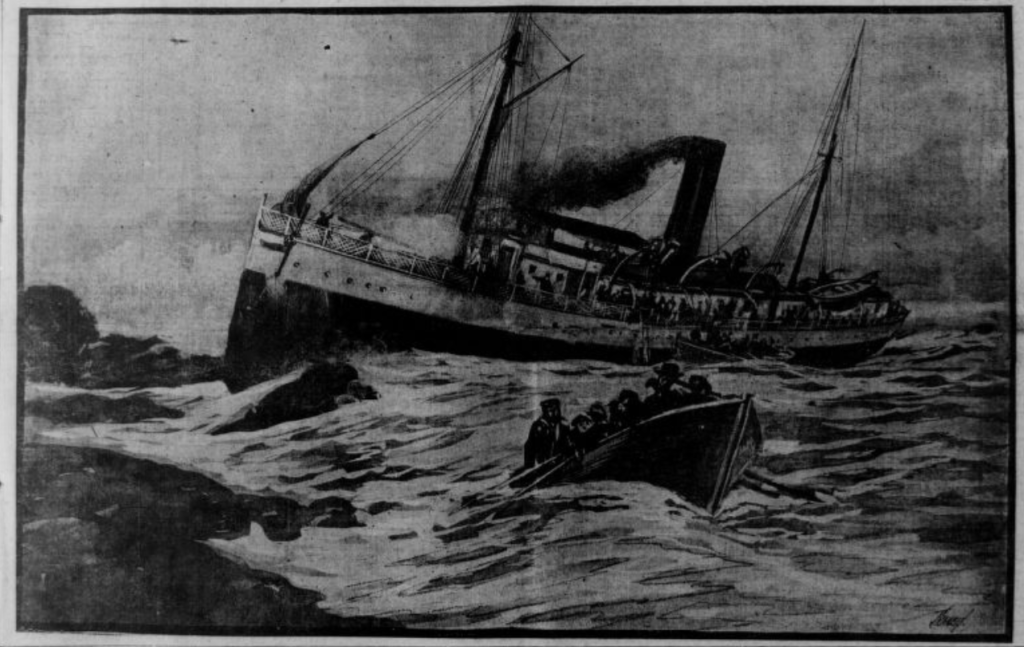
Raft of Survivors
When the steamer Topeka picked up the raft of survivors, it was reported that:
“When the Topeka picked up the raft, a terrible sea was running. One minute the raft was pushed on top of a wave and next was lost to view in a gully formed by the mountainous breakers. Eighteen men clung together on their frail support and battled bravely with a pair of oars to reach the Topeka, which owing to the dangerous coast could not run in any closer to them. When within about a half a mile from the raft a boat was lowered from the Topeka. [Then, with much difficulty,] a line was made to the raft. Spectators on the Topeka watched the struggling of the gallant seamen breathlessly. One minute they were high in the air and the next lost to sight. At last they succeeded in bringing the raft to the side of the steamer. The sight of the poor creatures on the raft brought tears to the eyes of the sailors. In stern of the raft sat an old man and three others were lying senseless in a heap in the center, washed by every swell and retained solely by the bodies of other men who were closely packed about.” [4]
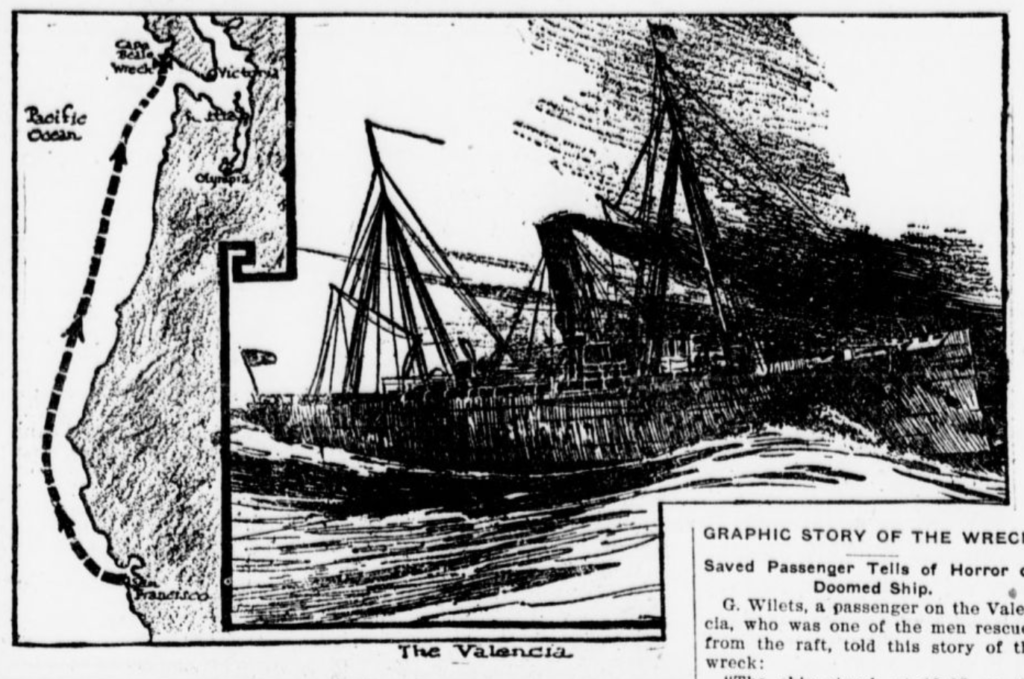
Rescue Attempts Failed
There were several attempts to rescue those who remained on board The Valencia, but all of them failed. The sea was too wild, and the steamer broke apart before any survivors could be brought to safety.
News out of Seattle said:
“[The] latest news from the wreck of Valencia is conflicting and discouraging. The report from the steamship Queen that twenty-five passengers were clinging to the vessel rigging and no possible chance of saving any of them, was followed by the story that the wreck had gone to pieces. The Queen was at the outer dock at Victoria when the first dispatch was sent. As only fifteen survivors have been heard from so far, it is probably that the loss of life will reach 139.” [5]
After families began receiving word that their loved ones did not survive the wreck of The Valencia, stories about the victims began to surface.
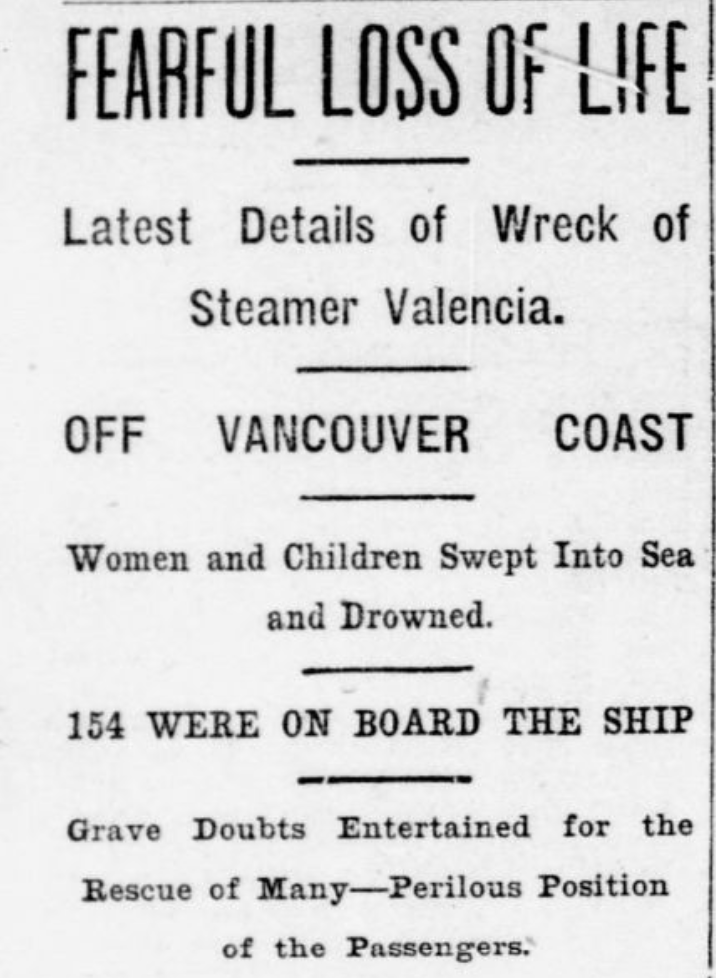
His First Trip
Twenty-eight-year-old Hermann T. Hoelscher had never before taken a trip on the water. He told his brothers that he needed to get away for a little while and needed a change for his health. So he booked his trip on the Valencia.
After his brothers learned of the wreck, they spent the day waiting to receive a telegram from Hermann. But, by nightfall, there was still no word.
When the news arrived that only a handful of men had survived, the brothers gave up hope. Only Hermann’s friends held onto the hope that Hermann had landed somewhere safe but could not send a telegram. [1]
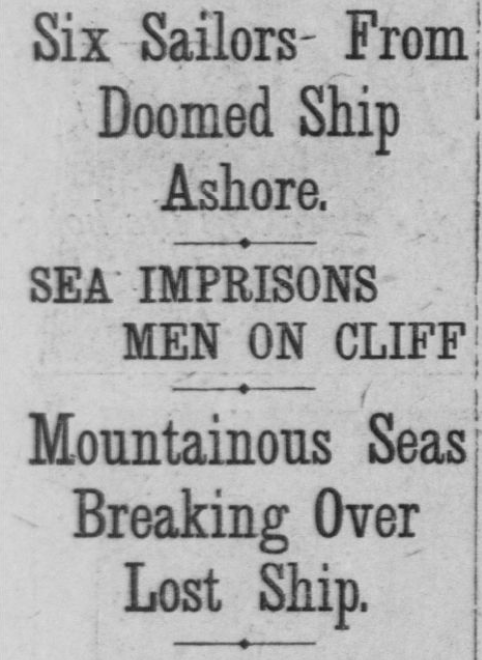
Left Her Daughter Behind
Mrs. Minnie Stewart received word that her mother had little time left to live. So she packed her bags and those of her daughter’s and made her way to her sister-in-law. As luck would have it, her sister-in-law insisted on keeping the 13-year-old daughter with her before Minnie boarded the Valencia.
The sister-in-law told a reporter:
“I tried to persuade [Minnie] to take the train as far as Seattle, but she would not listen to me. She said she preferred the comfort of a steamer to the changes from one train to another.”
The girl, her wondrous gray eyes brimming with tears, asked, “Do you think I will ever see my mamma again?” The reporter did not have it in his heart to tell her that she would not. [1]
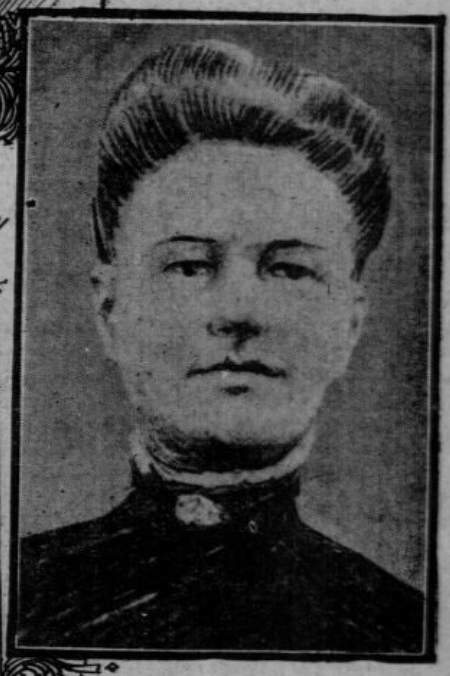
Laura Van Wyck
Almost two weeks after the tragedy, it was reported that a tug was returning to San Francisco with seven bodies. One of those bodies, it was believed, was Laura Van Wyck. [6]
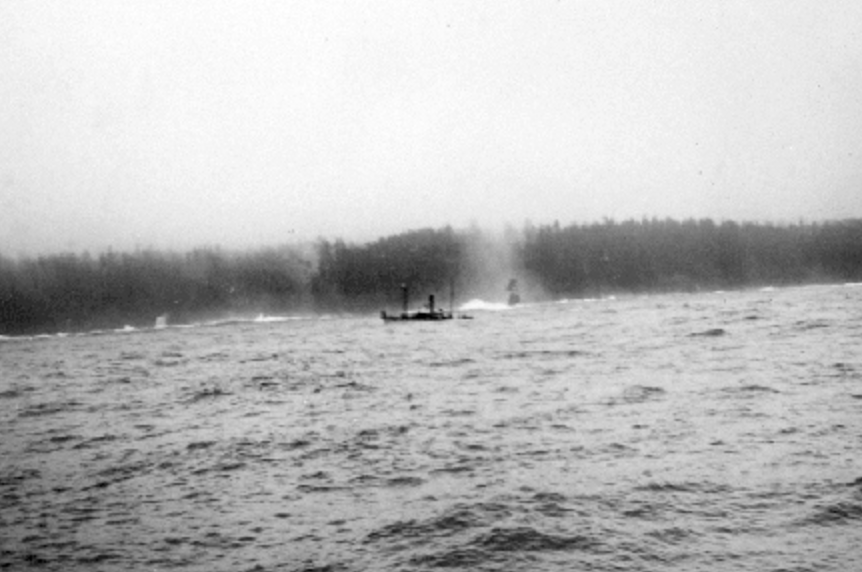
Skeleton Crew and Ghost Ship
Months after the wreck of The Valencia, there was a report that one of the Valencia’s lifeboats was spotted in a blocked cove. Inside the lifeboat were eight skeletons. [7]
For several years after the sinking of The Valencia, the phantom ship was seen crewed by skeletons with tortured figures hanging onto its rigging.
Sources:
1. The San Francisco call. (San Francisco [Calif.]), 25 Jan. 1906.
2. The Birmingham age-herald. (Birmingham, Ala.), 24 Jan. 1906.
3. The Jackson herald. (Jackson, Mo.), 22 Feb. 1906.
4. The Spokane press. (Spokane, Wash.), 25 Jan. 1906.
5. The Vinita daily chieftain. (Vinita, Indian Territory [Okla.]), 25 Jan. 1906.
6. The Bemidji daily pioneer. (Bemidji, Minn.), 05 Feb. 1906.
7. East Oregonian : E.O. (Pendleton, OR), 22 Aug. 1906.

